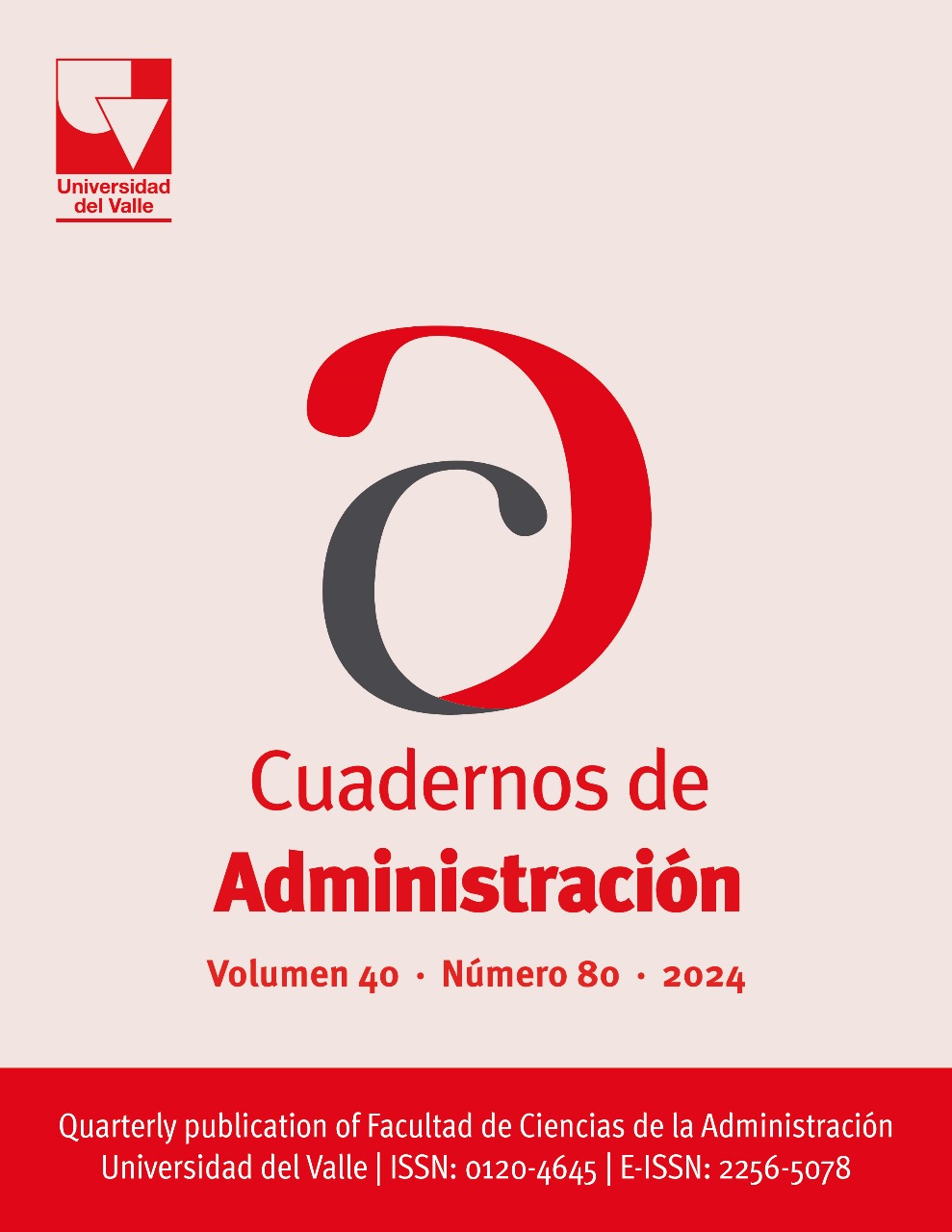Technological capabilities in the agricultural production units of Passifloras in the Huila department
Keywords:
Technological capabilities, Main components, Agricultural development, Agricultural productivity, PassiflorasMain Article Content
The following study focuses on evaluating the development of technological capabilities in the productive units dedicated to the cultivation of Passifloras in the Huila department. To accomplish this, the theoretical framework provided by CEPAL was employed, applying techniques of principal component analysis and the K-means algorithm to group the data obtained from the microdata of the Censo Nacional Agropecuario. The results revealed a low level of development in the technological capabilities from the evaluated productive units. It was identified that approximately 73% of these units had deficiencies in elements related to the effort indicator, in aspects such as the associativity among producers, the investment of economic resources in technology and equipment, as well as the implementation of soil improvement practices and pest control. On the other hand, as a notable strength, a significant participation was observed, averaging 55% of the productive units in the indicator of infrastructure. This included features such as the age of the machinery used and access to basic public services such as electricity and drinking water. These findings highlight the need for implementing policies and programs aimed at strengthening technological capabilities in Huila’s agricultural sector, with a particular focus on promoting associativity among producers, investment in technology and sustainable agricultural practices, as well as modernization of agricultural infrastructure. This comprehensive approach is essential for promoting sustainable and competitive agricultural development in the region.
Bell, M. & Pavitt, K. (1993). Technological Accumulation and Industrial Growth: Contrasts Between Developed and Developing Countries. Industrial and corporate change, 2(2), 157-210. https://doi.org/10.1093/icc/2.2.157 DOI: https://doi.org/10.1093/icc/2.2.157
Bernal, C. A. (2010). Metodología de la investigación (3rd ed.). Pearson.
Cohen, W., & Levinthal, D. (1990). Absorptive Capacity: A New Perspective on Learning and Innovation. Administrative Science Quarterly, 35(1), 128-152. https://doi.org/10.2307/2393553 DOI: https://doi.org/10.2307/2393553
Uribe Galvis, C. P. y Contreras Pedraza, C. A. (2021). Capacidad científica y tecnológica del Sistema Nacional de Innovación Agropecuaria (SNIA) en Colombia. Corporación Colombiana de Investigación Agropecuaria. https://doi.org/10.21930/agrosavia.analisis.7404715 DOI: https://doi.org/10.21930/agrosavia.analisis.7404715
De la Rosa, E., Rodriguez, E., y Acero F (2020). Diseño de un plan estratégico para la fomentación del uso de las TIC en la cadena de suministros de productos agrícolas (pasifloras) en el departamento del Huila. Corporación Universitaria Minuto de Dios. https://repository.uniminuto.edu/bitstream/10656/12583/5/TE.PRO_DelaRosaEddie-RodriguezErika-AceroFernando_2020.pdf
Departamento Administrativo Nacional de Estadística (DANE). (2014). Censo Nacional Agropecuario 2014. http://www.dane.gov.co
Gobernación del Huila. (2022). Re: Sistema de Información Regional SIR HUILA [Datos abiertos]. https://www.sirhuila.gov.co
Gollin, D. (2010). Chapter 73 Agricultural Productivity and Economic Growth. In Handbook of Agricultural Economics (Vol. 4, pp. 3825-3866). Handbook of Agricultural Economics. https://doi.org/10.1016/S1574-0072(09)04073-0 DOI: https://doi.org/10.1016/S1574-0072(09)04073-0
González, Y., Álvarez-Marqués, J., Rodríguez-Jiménez, S., Liriano-González, R., Ortiz-del Toro, L., y Pintado-Álvarez, I. (2023). Propuesta de prácticas para el manejo sostenible de los suelos en la finca “La Gabriela”. Revista Ingeniería Agrícola, 13(2), e05.https://www.redalyc.org/journal/5862/586275348005/html/
Hernández, R., Fernández, C., y Baptista, P. (2020). Metodología de la investigación (6ª ed.). McGRAW-HILL / Interamericana Editores, S.A.
Lall, S. (1992). Technological capabilities and industrialization. World Development, 20(2), 165-186. https://doi.org/10.1016/0305-750X(92)90097-F DOI: https://doi.org/10.1016/0305-750X(92)90097-F
Lugones, G. E., Gutti, P., y Le Clech, N. (2007). Indicadores de capacidades tecnológicas en América Latina. Estudios y perspectivas. CEPAL. https://www.cepal.org/sites/default/files/publication/files/5014/S0700876_es.pdf
MacQueen, J. B. (1967). Some Methods for Classification and Analysis of Multivariate Observations. In Proceedings of the 5th Berkeley Symposium on Mathematical Statistics and Probability (Vol. 1, pp. 281-297). University of California Press. http://projecteuclid.org/euclid.bsmsp/1200512992
Ministerio de Agricultura y Desarrollo Rural. (2021). Cadena del pasifloras Indicadores e instrumentos. Gobierno Nacional. https://sioc.minagricultura.gov.co/Pasifloras/Documentos/2021-03-31%20Cifras%20Sectoriales.pdf
Muñoz Velasco, L. A. y Andrade Gómez, M. V. (2024). Vocación de la estructura agrícola en el departamento del Huila. Estudios y Perspectivas Revista Científica y Académica, 4(1), 2190-2210. https://estudiosyperspectivas.org/index.php/EstudiosyPerspectivas/article/view/172 DOI: https://doi.org/10.61384/r.c.a..v4i1.172
Ocampo, J. (2013). Diversidad y distribución de las passifloraceae en el departamento del Huila en Colombia. Acta Biológica Colombiana, 18(3), 511-516. http://www.scielo.org.co/scielo.php?script=sci_arttext&pid=S0120-548X2013000300010&lng=en&tlng=es
Ocampo Osorio, L., Varón Devia, E., Monje Andrade, B., Sierra Baquero, P., y Ballestas Álvarez, K. (2020). Oferta tecnológica para el cultivo de maracuyá (p. 28). Corporación Colombiana de Investigación Agropecuaria (AGROSAVIA. https://doi.org/10.21930/agrosavia.brochure.7404470 DOI: https://doi.org/10.21930/agrosavia.brochure.7404470
Orrego, C., Salgado, N., y Diaz, M. (2021). Productividad y competitividad frutícola andina. Fondo Regional de Tecnología Agropecuaria (Fontagro) Banco Interamericano de Desarrollo. https://fontagro.org/new/uploads/productos/16111_-_Producto_9.pdf
Ramírez, J. y De aguas, J. (2017). Configuración territorial de las provincias de Colombia Ruralidad y redes. Comisión Económica para América Latina y el Caribe. https://repositorio.cepal.org/entities/publication/ed7da827-c1cc-4add-8f1c-ff079d5ef6eb
Sistema Departamental de Ciencia Tecnología e Innovación CODECYT-Huila. (2010). Plan estratégico de ciencia tecnología e innovación. Gobernación del Huila. https://minciencias.gov.co/sites/default/files/upload/paginas/pedcti-huila.pdf
Unidad de Planificación Rural Agropecuaria (UPRA) (2022). La frontera agrícola: Diagnóstico y propuestas de política. https://upra.gov.co/es-co/Documents/01_Frontera_Agricola.pdf
Downloads

This work is licensed under a Creative Commons Attribution-NonCommercial-NoDerivatives 4.0 International License.

